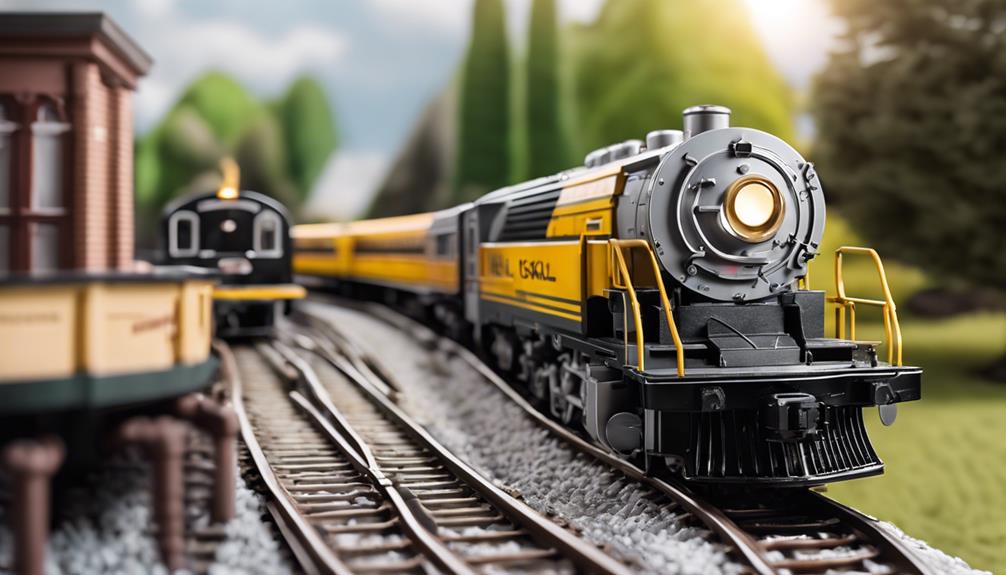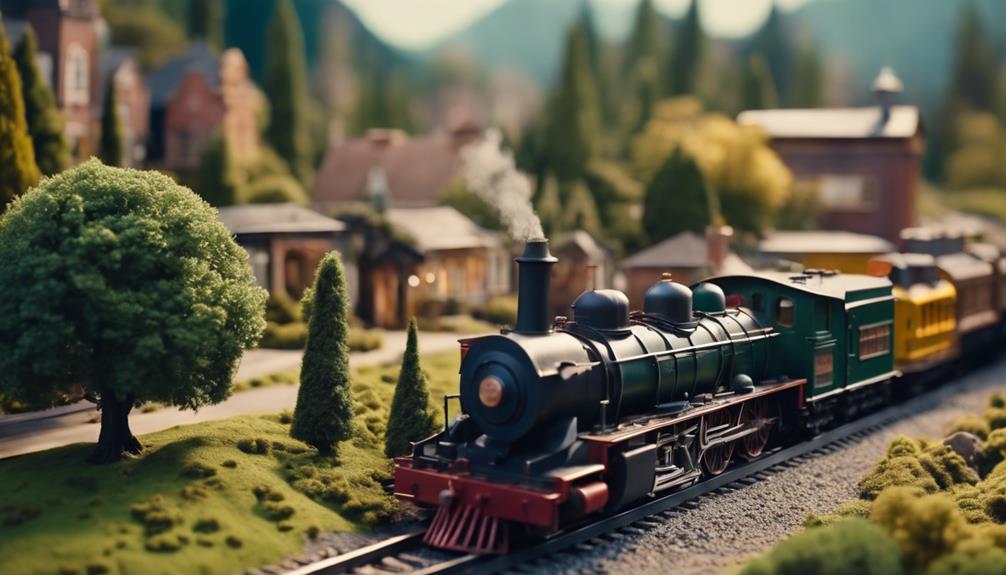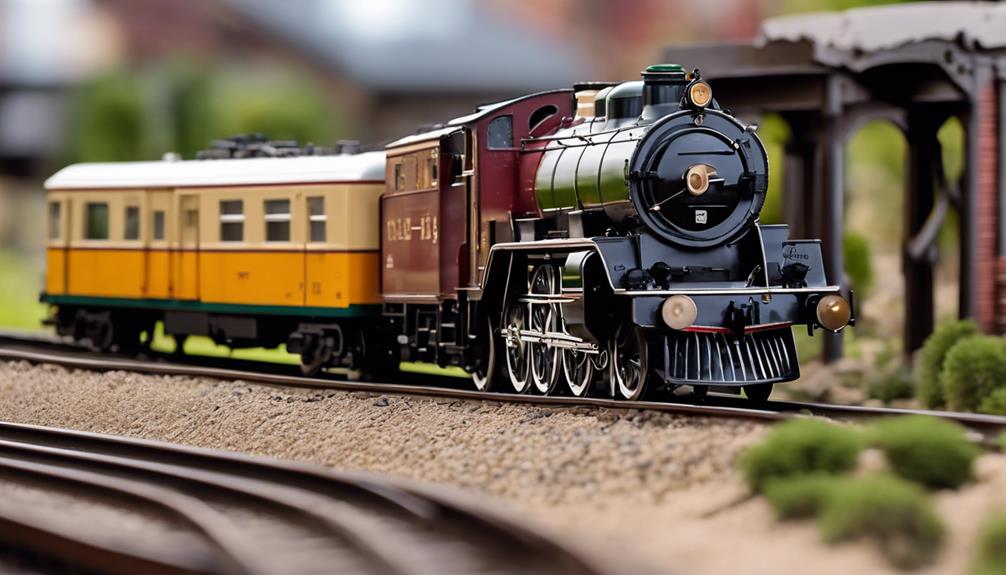
When comparing Lionel O27 and O trains, the primary differences are in size, track needs, and compatibility. O gauge models are larger than O27 trains, requiring more layout space. O27 runs on narrower tracks than O gauge. Matching locomotives to track size is important – O27 for O27 tracks, O for O tracks. Check compatibility to avoid mishaps and consider weight and length for rolling stock. Improve your setup with accessories for a more engaging experience. While O27 is more common and affordable, O gauge trains are rarer and hold better value. Stay tuned for more insights into these fascinating train types.
History of Lionel O27 and OWhen comparing the history of Lionel O27 and O gauge model trains, it becomes evident that their development paths veered significantly. Lionel O27 trains were introduced in 1927 as a budget-friendly option, featuring a smaller size and simpler construction than the standard O gauge trains. These O27 models quickly gained https://storage.googleapis.com/ask-the-guide/news/model-train-tips/transform-your-model-railway-essential-tips-for-crafting-stunning-background.html popularity due to their affordability and accessibility, appealing to both novice hobbyists and seasoned collectors.
On the other hand, Lionel’s O gauge trains have a longer history, dating back to the early 1900s when they were first produced. The O gauge trains were known for their robust build quality and intricate details, catering to enthusiasts who valued authenticity and craftsmanship.
Throughout the years, both Lionel O27 and O gauge trains have evolved to meet the changing demands of the model train community. Safety has always been a top priority in their development, with manufacturers implementing various features to ensure smooth operation and minimal risks. As you delve into the history of these iconic model trains, you’ll uncover how innovation and dedication have shaped the hobby into what it’s today.
Size Comparison: O27 Vs. OWhen comparing O27 and O gauge trains, the size differences are significant and play an important role in determining compatibility with tracks and accessories. Understanding these size variations can help you make informed decisions when expanding your model train collection.
Additionally, exploring the historical significance of each size can provide valuable insights into the evolution of Lionel trains over the years.
Size Differences ExplainedComparing the sizes of Lionel O27 and O gauge model trains reveals noticeable differences in scale and dimensions. O gauge trains are larger than O27 trains, with O gauge models typically measuring around 1:48 scale and O27 models closer to 1:64 scale. This means that O gauge trains are more substantial and have a more prominent presence on your layout compared to O27 trains.
When setting up your model train display, be mindful of the space required for O gauge trains due to their larger size. Always make sure that there’s enough room between tracks and structures to prevent any collisions or derailments, promoting a safer and more enjoyable model train experience.
Track Compatibility ComparisonTo evaluate the compatibility of tracks between O27 and O gauge model trains, consider the differences in their sizes and dimensions. O27 track is slightly narrower than O gauge track, with O27 measuring at 1 1/4 inches wide while O gauge is 1 1/4 inches wide.
While some O gauge trains can run on O27 track, it’s advisable to make sure O27 trains on O gauge track due to the potential for derailments or other safety hazards. If you wish to mix tracks, make certain that the transition points are smooth and secure to prevent accidents.
Always prioritize safety when setting up your model train tracks to avoid any damage to your trains or potential injuries.
Historical Significance of EachConsidering the historical significance of each, the size comparison between O27 and O gauge model trains reveals important distinctions that have influenced their respective roles in the model train hobby.
O gauge trains, introduced in the early 20th century, were the first widely adopted model train size, known for their durability and detail.
O27 gauge trains, emerging later, were a smaller, more affordable alternative designed to navigate tighter curves. This distinction impacted the accessibility and versatility of O27 trains, appealing to a broader audience.
Understanding the historical context behind these sizes can enrich your appreciation for the evolution of model trains and help you make informed decisions when building your own collection.
Always prioritize safety when enjoying your model trains to guarantee a fun and secure experience.
Track Dimensions: O27 Vs. OThe track dimensions of O27 differ from those of the O scale model trains. O27 track is slightly narrower, measuring 27mm between the outer rails compared to the 32mm spacing of O scale track. This variation may seem important, but it’s vital to make sure you use the correct track for your trains. Using the wrong track size can lead to derailments, damage to your trains, or even safety hazards. When setting up your model train layout, make sure to double-check the track dimensions to match your trains correctly.
To guarantee safe operation, always follow the manufacturer’s recommendations regarding track sizes. Mixing different track sizes can cause alignment issues and disrupt the smooth running of your trains. By paying attention to these track dimension variances, you can maintain a safe and enjoyable model train experience. Remember, safety should always be a top priority in setting up your model train tracks!
Locomotive Compatibility DifferencesWhen considering locomotive compatibility differences between Lionel O27 and O gauge trains, it’s vital to make sure that your locomotive matches the track you have. If the locomotive and track aren’t https://s3.us-east-1.amazonaws.com/ask-the-guide-today/reviews/model-train-tips/what-scale-were-american-flyer.html compatible, it can lead to operational issues and even potential safety hazards.
Lionel O27 locomotives are designed to run on O27 track specifically, while O gauge locomotives are meant for O gauge track. Mixing these can result in derailments, electrical problems, or damage to the trains. It’s important to check the product specifications to confirm that you’re using the right locomotive for your track.
To keep your model train experience safe and enjoyable, always verify compatibility between your locomotive and track. This simple step can prevent accidents and frustrations down the line. By following these guidelines, you can ensure that your model train operations run smoothly and without any hiccups.
Rolling Stock VariationsFor a thorough understanding of the differences between Lionel O27 and O gauge trains, it’s important to investigate the various rolling stock variations available in each gauge. When it pertains to rolling stock, both O27 and O gauge offer a wide array of options including boxcars, tank cars, flat cars, and more. These variations can enrich the realism and excitement of your model train setup.
When choosing rolling stock for your layout, it’s vital to take into account factors such as weight, length, and compatibility with your locomotives and track. Making sure that your rolling stock is well-suited to your layout can help prevent derailments and other potential safety hazards.
Moreover, different rolling stock variations can add diversity to your train collection, allowing you to create unique and visually appealing train compositions. Whether you prefer classic steam engines pulling a string of colorful boxcars or modern diesel locomotives hauling heavy freight cars, the rolling stock variations available in both Lionel O27 and O gauge offer ample opportunities for customization and creativity.
Accessories and Add-OnsConsider enhancing various accessories and add-ons to upgrade your Lionel O27 or O gauge train setup. Enhancing your train layout with accessories not only adds visual interest but also increases the overall enjoyment of the experience. When selecting accessories, prioritize safety by ensuring they’re compatible with your specific track system and train model. Look for features like automatic shut-offs to prevent overheating and short circuits, especially if you plan to leave your train unattended for periods.
Invest in a variety of accessories such as crossing gates, signals, and lighting kits to bring your train world to life. These additions not only create a more realistic environment but also provide interactive elements for you to control. Consider adding buildings, figures, and landscaping features to complete the scene. Remember to regularly inspect and maintain your accessories to prevent malfunctions that could pose safety hazards. By incorporating these accessories thoughtfully, you can enhance your train setup while ensuring a safe and enjoyable experience for everyone involved.
Pricing and CollectibilityWhen considering Lionel O27 and O trains, the pricing and collectibility aspects play a significant role in enthusiasts’ decisions.
You’ll find variations in pricing between O27 and O models, influenced by factors like rarity and demand.
Understanding the comparative collectibility and value over time can guide your choices in expanding your collection.
Price DifferencesIf you’re looking to understand the price differences between Lionel O27 and O trains, exploring their pricing and collectibility can provide valuable insights into their distinct market values.
Lionel O27 trains are typically more affordable than O gauge trains due to their smaller size and simpler construction. The O gauge trains, being larger and often more detailed, tend to be priced higher in the market.
Concerning collectibility, certain limited edition or vintage O gauge trains can command significantly higher prices compared to their O27 counterparts. Keep in mind that factors like Z scale track sizes condition, rarity, and demand also play an important role in determining the prices of these trains.
Whether you’re a novice or a seasoned collector, understanding these price differences can help you make informed decisions when expanding your train collection.
Rarity ComparisonTo further grasp the pricing and collectibility of Lionel O27 and O trains, it’s crucial to compare their rarity in the market. In terms of rarity, Lionel O27 trains are generally more common and easier to find compared to the larger O gauge trains. Due to their greater availability, O27 trains are often priced more affordably and are a good starting point for beginners or those on a budget.
On the other hand, O gauge trains tend to be rarer and therefore more collectible. This scarcity can drive up their prices, making them a prized possession for serious collectors. Keep in mind that rarity alone doesn’t determine value; factors like condition, originality, and historical significance also play important roles in pricing and collectibility.
Value Over TimeComparing the pricing and collectibility of Lionel O27 and O trains over time reveals significant differences in their value and desirability among collectors and enthusiasts. Lionel O gauge trains, being larger and often more intricately detailed, tend to hold their value better over time compared to O27 trains. The O gauge trains are typically seen as more collectible due to their higher level of detail, larger size, and historical significance.
On the other hand, O27 trains, while still valued by enthusiasts, may not appreciate in value as much as O gauge trains. Factors such as rarity, condition, and demand play vital roles in determining the value of these trains over time. As a collector, understanding these nuances can guide you in making informed decisions about purchasing and collecting Lionel trains.
Frequently Asked Questions Are Lionel O27 and O Track Systems Compatible With Each Other?Yes, Lionel O27 and O track systems are compatible with each other. You can easily connect them for a seamless layout. Enjoy the flexibility and creativity these systems offer without worrying about compatibility issues.
Can Lionel O Locomotives Run on Lionel O27 Tracks?Yes, Lionel O locomotives can operate on Lionel O27 tracks. Just make sure your locomotive and track are compatible to avoid any issues. Always prioritize safety by double-checking compatibility before running your trains.
What Are the Main Differences in Electrical Systems Between O27 and O?When comparing the electrical systems of Lionel O27 and O, note that O27 typically features a simpler power system with lower voltage requirements. Grasping these differences helps guarantee safe and efficient operation of your trains.
Is There a Noticeable Difference in Detail Between O27 and O Rolling Stock?When comparing O27 and O rolling stock, you’ll notice that O scale models tend to have more Model train scales explained for beginners intricate details and higher quality finish, making them more lifelike. This can elevate your overall model railroad experience.
Are There Any Unique Accessories Specific to Either Lionel O27 or O?When choosing between Lionel O27 and O, consider unique accessories. O27 offers classic options, while O provides a wider range with more advanced features. Confirm compatibility with your set to enrich your model train experience.

